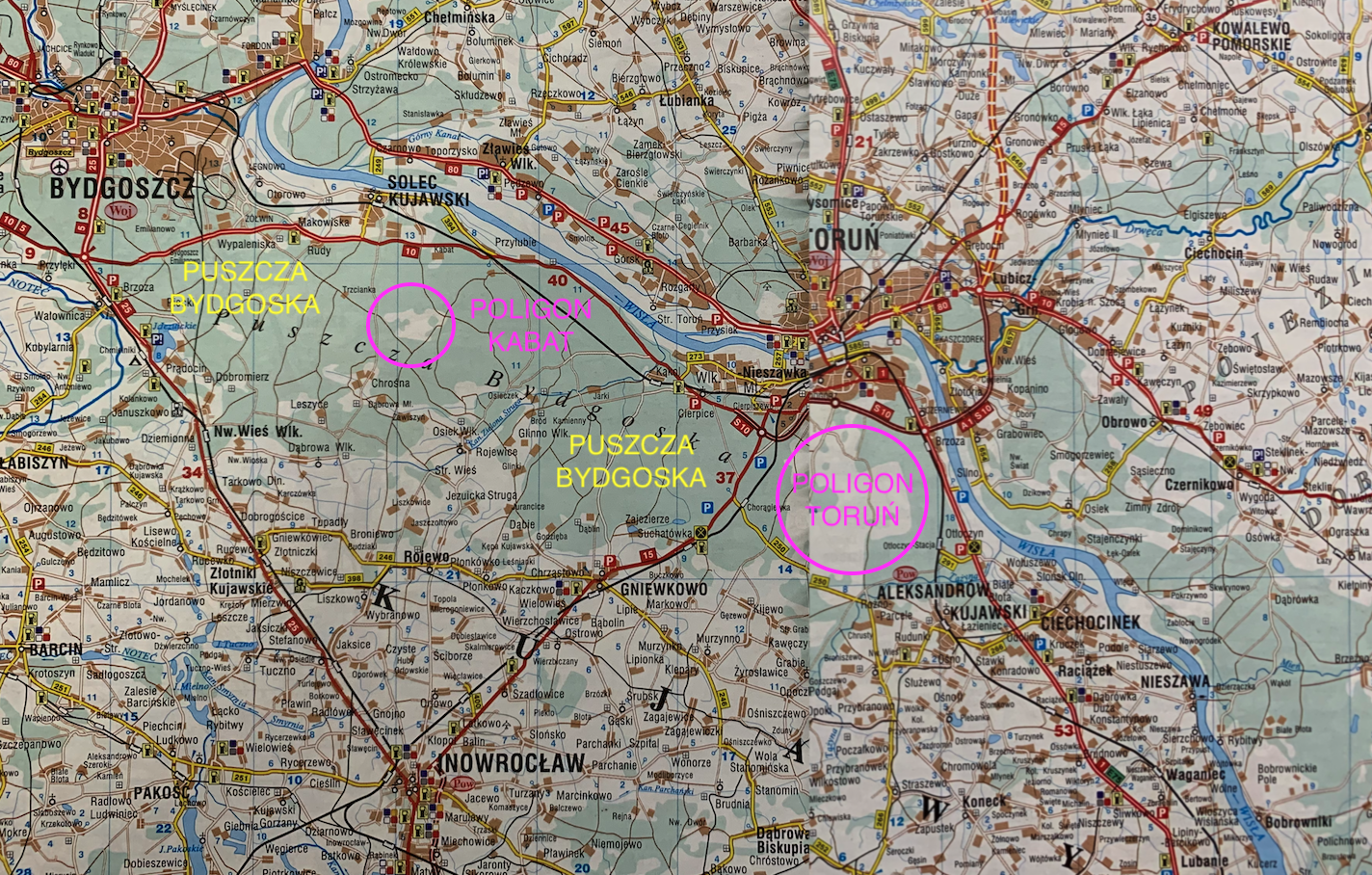Solec Kujawski 2022-12-10
Former Kabat training ground near Solec Kujawski.
Geographic coordinates: 53.018N 18.261E.
The article describes the former Kabat airfield near Solec Kujawski (Kuyavian-Pomeranian Voivodeship). The training ground was located in the Bydgoszcz Forest. The Bydgoszcz Forest is a forest complex located south of the line of the Vistula River: the city of Bydgoszcz - Toruń. The forest covers an area of about 50,000 hectares. The forest also includes Las Kujawski and Las Miedzyński, which directly surround Bydgoszcz from the south. The forest stretches from the east (Aleksandrów Kujawski) to the west (Potulice) for about 80 kilometers. At its widest point, the Forest is about 20 km long.

The eastern section of the Bydgoszcz Forest, between the Toruń - Gniewkowo and Toruń - Aleksander Kujawski railway lines, is occupied by the active Toruń Training Ground. It is an artillery range.
The forest is dominated by coniferous forests with an admixture of various deciduous trees. The soils are mostly sandy. In many places, you can find dune hills, the highest of which, Góra Szwedzka, is 116 m above sea level, with an average height of about 55 m above sea level.
In the middle of the Bydgoszcz Forest was the hamlet of Kabat, which was established in the 17th century. In the eighteenth century, the settlement had about 30 farms. There was also a one-room folk school. The settlement functioned until the start of the Second World War by the Germans. The hamlet was located by the forest road from Solec Kujawski, about 8 km from the national road No. 10. This forest road is now called the Yellow Trail. The houses in the hamlet were loosely located in the forest and along the current national road No. 10.
In the autumn of 1939, the Germans started the construction of the Dynamit AG (DAG) Vorm Alfred Nobel & CO Bromberg armaments plant hidden in the forests of the Bydgoszcz Forest in Łęgnów with the hands of about 40,000 prisoners. Currently (2022) within the boundaries of Bydgoszcz. 16 forced labor camps were built around it, in which Soviet, French, English, Italian and Yugoslav prisoners were imprisoned. About 2,500 Jewish women worked here, transported from the camp in Stuthof, and after several weeks of murderous work, they were transported to KL Auschwitz to die. The factory produced TNT, nitrocellulose powder, initiating materials, hexogen and dinitrobenzene. Unguided rocket shells and mortar shells were also produced.
In the spring of 1940, in connection with the construction of a large explosives factory DAG Fabrik Bromberg near Łęgnów, the German authorities decided to create a testing ground in the Bydgoszcz Forest. The inhabitants of Kabaty were displaced in 1941, on the order of the German occupation authorities, and the inner area of the forest was prepared for military purposes. Even now (2022), few traces of the hamlet can be found. There are wild fruit trees and, above all, an Evangelical cemetery with tombstones.
The Germans turned the middle of the forest into a test center for weapons, mainly missiles. Unguided missiles were tested, which were brought from the DAG Fabrik Bromberg factory, where the rockets were reloaded. Mortar shells were also tested. The remnant of the training ground is a reinforced concrete tower, which the locals call an observation tower. Her condition suggests she must have been a target later. Probably the training ground was not completely completed until January 1945.
In 1945, the training ground was taken over by the Polish Army, which transformed the area into an aviation training ground. It was used by air units stationed at the airports in Bydgoszcz and Inowrocław. Unused tanks and helicopters were brought to the training ground and served as targets. There were also silhouette targets of bomber planes. A steel observation tower was also built, from which air exercises were directed. The tower was dismantled at the beginning of the 1990s.
Until 1994, the area of the training ground was inaccessible to the civilian population. This year, the area was taken over by the State Forests. Due to the disaster of the radio mast in Gąbin, it was decided to build a new broadcasting station on the site of the former training ground. On September 4, 1999, the Radio Broadcasting Center of the 1st Polish Radio Program was launched. Two masts were built: 289 and 330 m, with which Program I of Polish Radio is broadcast throughout the country and abroad. It is a long-wave broadcasting station with a frequency of 225 kHz.
Even today (2022) you can find unexploded ordnance bombs and exercise bombs dropped from planes in the former training ground.
Written by Karol Placha Hetman
